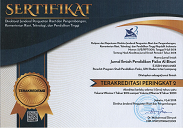Peer Instruction Using PhET Integrated with Inquiry-based Learning in Kinematics Physics Learning
Abstract
Keywords
Full Text:
PDFReferences
Bao, L., & Koenig, K. (2019). Physics education research for 21st century learning. Disciplinary and Interdisciplinary Science Education Research, 1(1), 1–12. https://doi.org/10.1186/s43031-019-0007-8
Beichner, R. J. (1994). Testing student interpretation of kinematics graphs. American Journal of Physics, 62(8), 750–762. https://doi.org/10.1119/1.17449
Bektasli, B., & White, A. L. (2012). The relationships between logical thinking, gender, and kinematics graph interpretation skills. Egitim Arastirmalari - Eurasian Journal of Educational Research, 48(48), 1–19.
Berryhill, E., Herrington, D., & Oliver, K. (2016). Kinematics Card Sort Activity: Insight into Students’ Thinking. The Physics Teacher, 54(9), 541–544. https://doi.org/10.1119/1.4967894
Bollen, L., Cock, M. De, Zuza, K., Guisasola, J., & Kampen, P. Van. (2016). Generalizing a categorization of students ’ interpretations of linear kinematics graphs. 010108, 1–10. https://doi.org/10.1103/PhysRevPhysEducRes.12.010108
Bunterm, T., Lee, K., Ng Lan Kong, J., Srikoon, S., Vangpoomyai, P., Rattanavongsa, J., & Rachahoon, G. (2014). Do Different Levels of Inquiry Lead to Different Learning Outcomes? A comparison between guided and structured inquiry. International Journal of Science Education, 36(12), 1937–1959. https://doi.org/10.1080/09500693.2014.886347
Cahyani, V. D., & Pranata, O. D. (2023). Studi Aktivitas Belajar Sains Siswa di SMA Negeri 7 Kerinci. Lensa (Lentera Sains): Jurnal Pendidikan IPA, 13(2), 137–148. https://doi.org/10.24929/lensa.v13i2.317
Chamberlain, J. M., Lancaster, K., Parson, R., & Perkins, K. K. (2014). How guidance affects student engagement with an interactive simulation. Chemistry Education Research and Practice, 15(4), 628–638. https://doi.org/10.1039/c4rp00009a
Cohen, J. (1988). Statistical Power Analysis for the Behavioral Science. Second Edition. Lawrence Erlbaum Associates.
Cohen, L., Manion, L., & Morrison, K. (2018). Research Methods in Education (Eighth edi). Routledge.
Creswell, J. W., & Clark, V. L. P. (2017). Designing and Conducting Mixed Methods Research (Third Edit). Sage.
Crouch, C. H., & Mazur, E. (2001). Peer Instruction: Ten years of experience and results. American Journal of Physics, 69(9), 970–977. https://doi.org/10.1119/1.1374249
Fagen, A. P., Crouch, C. H., & Mazur, E. (2002). Peer Instruction: Results from a Range of Classrooms. The Physics Teacher, 40(4), 206–209. https://doi.org/10.1119/1.1474140
Guidugli, S., Gauna, C. F., & Benegas, J. (2005). Graphical Representations of Kinematical Concepts: A Comparison of Teaching Strategies. The Physics Teacher, 43(6), 334–337. https://doi.org/10.1119/1.2033514
Hake, R. R. (1998). Interactive-Engagement vs. Traditional Methods: A Six-Thousand-Student Survey of Mechanics Test Data for Introductory Physics Courses. American Journal of Physics, 66(64), 1–26.
Hale, P. L. (2000). Kinematics and Graphs : Students ’ Difficulties and CBLs. The Mathematics Teacher, 93(5), 414–417.
Haleem, A., Javaid, M., Qadri, M. A., & Suman, R. (2022). Understanding the role of digital technologies in education: A review. Sustainable Operations and Computers, 3(1), 275-258. https://doi.org/10.1016/j.susoc.2022.05.004
Hasan, S., Bagayoko, D., & Kelley, E. L. (1999). Misconceptions and the certainty of response index (CRI). Physics Education, 34(5), 294–299. https://doi.org/10.1088/0031-9120/34/5/304
Heydari, H., Zarei, E., Zainalipour, H., & Abbas, B. (2013). Survey the Effect of Cooperative Learning on Confidence. 3(4), 360–363.
Ibrahim, B., & Rebello, N. S. (2012). Representational task formats and problem solving strategies in kinematics and work. Physical Review Special Topics - Physics Education Research, 8(1), 1–19. https://doi.org/10.1103/PhysRevSTPER.8.010126
Jewett, J. W. (2008). Energy and the Confused Student I: Work. The Physics Teacher, 46(1), 38–43. https://doi.org/10.1119/1.2823999
Jufriadi, A., Kusairi, S., & Sutopo, S. (2021). Exploration of student’s understanding of distance and displacement concept. Journal of Physics: Conference Series, 1869(1). https://doi.org/10.1088/1742-6596/1869/1/012195
Jugueta, E. A. D., Go, C. K. C., & Indias, J. M. M. (2012). Free fall misconceptions: A comparison between science and non-science university majors. Am. J. Phys. Educ, 6, 145. http://www.lajpe.org
Knight, J. K., & Brame, C. J. (2018). Peer instruction. CBE Life Sciences Education, 17(2), 1–4. https://doi.org/10.1187/cbe.18-02-0025
Lasry, N., Mazur, E., & Watkins, J. (2008). Peer instruction: From Harvard to the two-year college. American Journal of Physics, 76(11), 1066–1069. https://doi.org/10.1119/1.2978182
Laverty, J., & Kortemeyer, G. (2012). Function plot response: A scalable system for teaching kinematics graphs. American Journal of Physics, 80(8), 724–733. https://doi.org/10.1119/1.4719112
Lemmer, M. (2013). Nature, Cause and Effect of Students’ Intuitive Conceptions Regarding Changes in Velocity. International Journal of Science Education, 35(2), 239–261. https://doi.org/10.1080/09500693.2011.647110
Mazur, E. (1997). Peer Instruction: A user’s manual. Prentice Hall.
Mazur, E. (2014). Peer Instruction: A User’s Manual (Person New). Pearson Education.
McDermott, L. C., Rosenquist, M. L., & van Zee, E. H. (1987). Student difficulties in connecting graphs and physics: Examples from kinematics. American Journal of Physics, 55(6), 503–513. https://doi.org/10.1119/1.15104
Morgan, G. A., Leech, N. L., Gloeckner, G. W., & Barret, K. C. (2004). SPSS for Introductory Statistics. Use and Interpretation. Lawrence Erlbaum Associates, Inc. All.
Motlhabane, A. (2016). Learner’s alternative and misconceptions in physics: A phenomenographic study. Journal of Baltic Science Education, 15(4), 424–440. https://doi.org/10.33225/jbse/16.15.424
Nieminen, P., Savinainen, A., & Viiri, J. (2012). Relations between representational consistency, conceptual understanding of the force concept, and scientific reasoning. Physical Review Special Topics - Physics Education Research, 8(1), 1–10. https://doi.org/10.1103/PhysRevSTPER.8.010123
Pranata, O. D. (2023). Physics Education Technology (PhET) as Confirmatory Tools in Learning Physics. Jurnal Riset Fisika Edukasi Dan Sains, 10(1), 29–35. https://doi.org/10.22202/jrfes.2023.v10i1.6815
Pranata, O. D., Sastria, E., Ferry, D., & Zebua, D. R. Y. (2023). Analysis of Students’ Emotional Intelligence and Their Relationship with Academic Achievement in Science. Proceedings of the International Conference on Social Science and Education, ICoeSSE, 395–410. https://doi.org/10.2991/978-2-38476-142-5
Pranata, O. D., & Seprianto, S. (2023). Pemahaman Konsep Siswa Melalui Skema Blended learning Menggunakan Lembar Kerja Berbasis Simulasi. Karst : Jurnal Pendidikan Fisika Dan Terapannya, 6(1), 8–17. https://doi.org/https://doi.org/10.46918/karst.v6i1.1724
Pranata, O. D., Yuliati, L., & Wartono. (2017). Concept Acquisition of Rotational Dynamics by Interactive Demonstration and Free-Body Diagram. Journal of Education and Learning (EduLearn), 11(3), 291–298. https://doi.org/10.11591/edulearn.v11i3.6410
Rosenquist, M. L., & McDermott, L. C. (1987). A conceptual approach to teaching kinematics. American Journal of Physics, 55(5), 407–415. https://doi.org/10.1119/1.15122
Soeharto, S. (2021). Development of A Diagnostic Assessment Test to Evaluate ScienceMisconceptions in Terms of School Grades: A Rasch MeasurementApproach. Journal of Turkish Science Education, 18(3), 351–370. https://doi.org/ 10.36681/tused.2021.78
Sokoloff, D. R., Thornton, R. K., & Laws, P. W. (2011). RealTime Physics Active Learning Laboratories Module 1 Mechanics (Vol. 15). http://books.google.com/books?hl=en&lr=&id=GjkvDKvZVrYC&pgis=1
Sokolowski, A. (2017). Graphs in kinematics - A need for adherence to principles of algebraic functions. Physics Education, 52(6). https://doi.org/10.1088/1361-6552/aa873d
Sutopo, Hidayah, N., Wisodo, H., & Haryoto, D. (2020). Improving students’ understanding of kinematics concepts through multi-representational learning. AIP Conference Proceedings, 2215(April). https://doi.org/10.1063/5.0004063
Sutopo, & Waldrip, B. (2013). Impact of a Representational Approach on Students ’. International Journal of Science and Mathematics Education, 12(November 2012), 741–766. https://link-springer-com.ezproxy.utm.my/content/pdf/10.1007%2Fs10763-013-9431-y.pdf
Testoni, L. A., & Brockington, G. (2016). The use of smartphones to teach kinematics: An inexpensive activity. Physics Education, 51(6). https://doi.org/10.1088/0031-9120/51/6/063008
Wee, L. K., Tan, K. K., Leong, T. K., & Tan, C. (2015). Using Tracker to understand “toss up” and free fall motion: A case study. Physics Education, 50(4), 436–442. https://doi.org/10.1088/0031-9120/50/4/436
Wemyss, T., & Van Kampen, P. (2013). Categorization of first-year university students’ interpretations of numerical linear distance-time graphs. Physical Review Special Topics - Physics Education Research, 9(1), 1–17. https://doi.org/10.1103/PhysRevSTPER.9.010107
Wenning, C. J. (2011). The Levels of Inquiry Model of Science Teaching. J. Phys. Tchr. Educ. Online, 6(2), 9–16.
Wieman, C. E., Adams, W. K., Loeblein, P., & Perkins, K. K. (2010). Teaching Physics Using PhET Simulations. The Physics Teacher, 48(4), 225–227. https://doi.org/10.1119/1.3361987
Wieman, C. E., & Perkins, K. K. (2006). A powerful tool for teaching science. Nature Physics, 2(5), 290–292. https://doi.org/10.1038/nphys283
Winter, J. de, & Hardman, M. (2020). Teaching Secondary Physics. In J. de Winter & M. Hardman (Eds.), Teaching Secondary Science (3rd ed.). https://books.google.com.my/books?id=ZSoryQEACAAJ
DOI: http://dx.doi.org/10.24042/jipfalbiruni.v13i2.19299
Refbacks
- There are currently no refbacks.

Jurnal ilmiah pendidikan fisika Al-Biruni is licensed under a Creative Commons Attribution-ShareAlike 4.0 International License.
![]()







